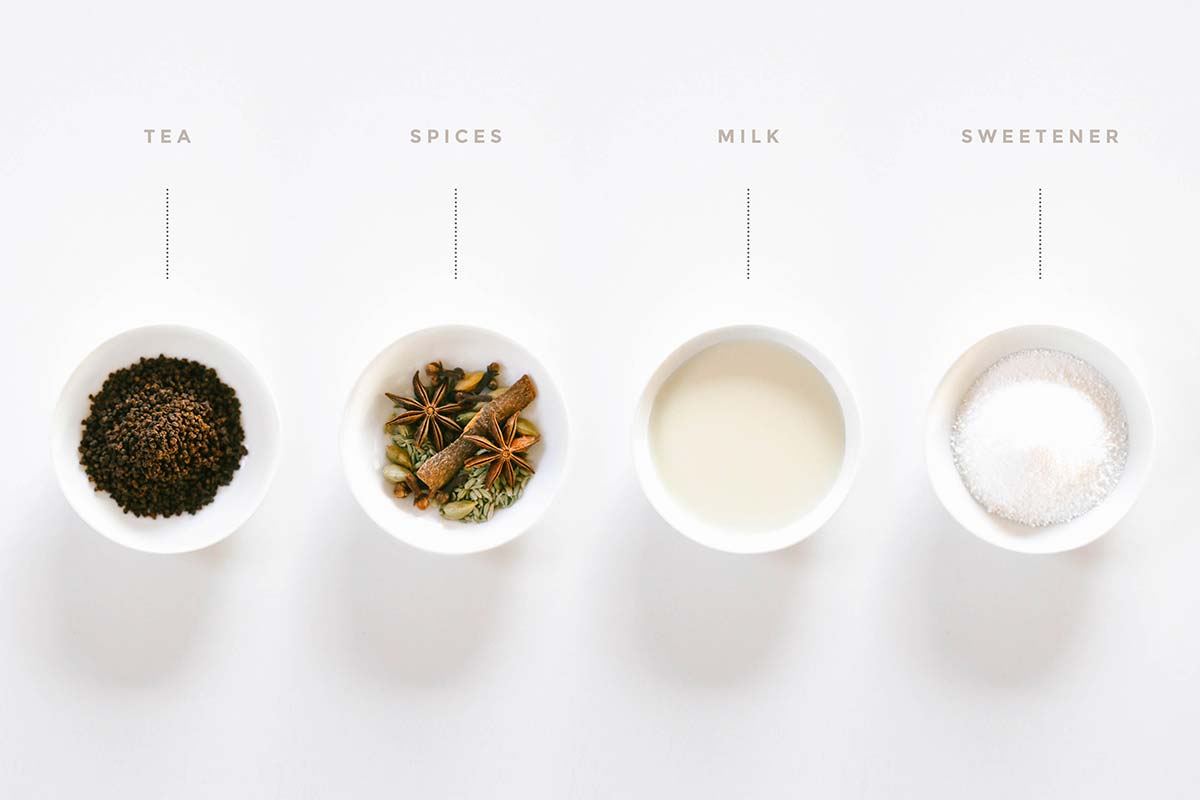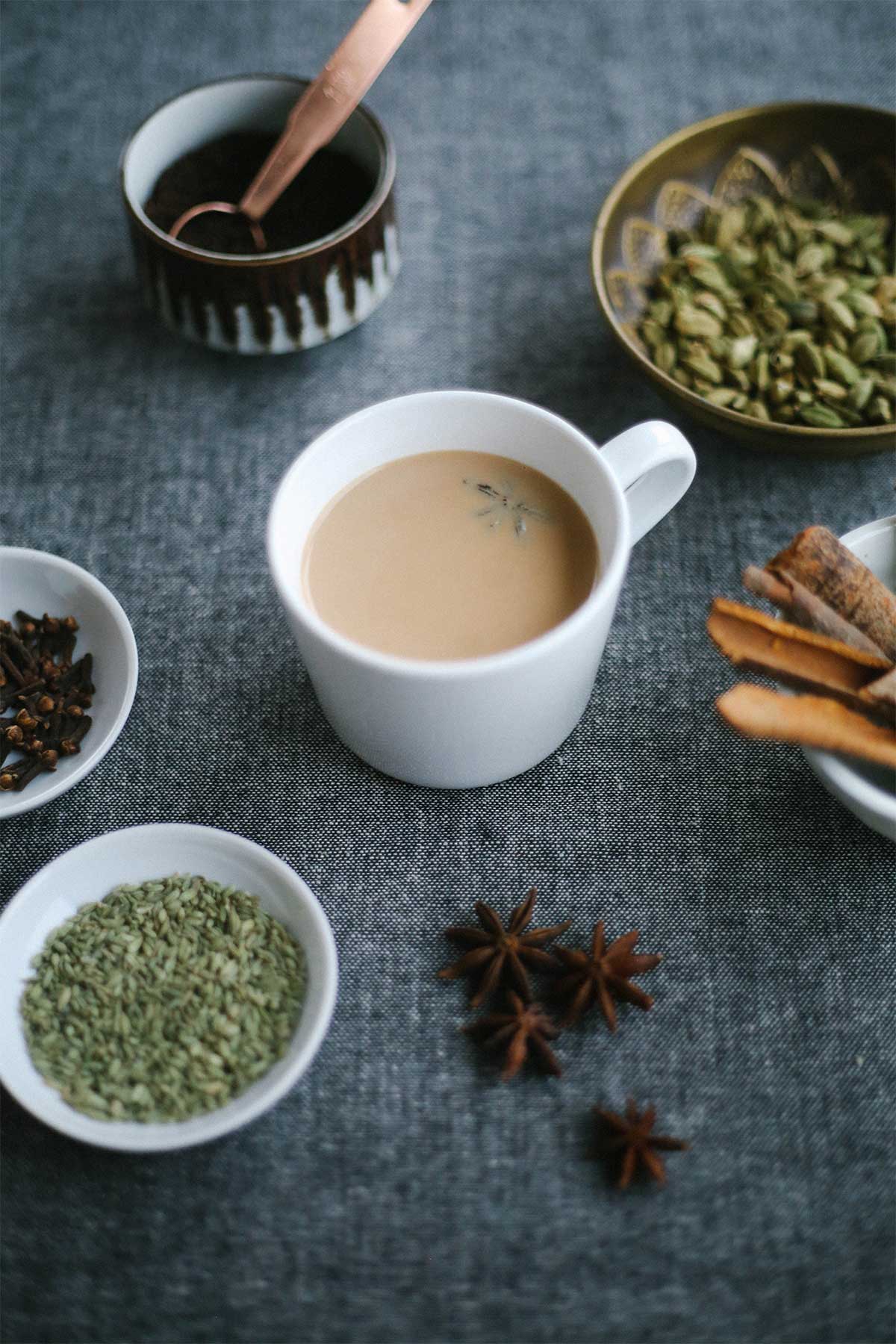Each morning we spent in New Delhi, my partners grandmother would insist on making me a masala chai. The aromas floating out of her kitchen were incredible and I came to crave this spicy steamed milk tea at the start of each day. The strange thing is that since leaving India I’ve rarely touched it since. I suppose I felt that nothing would be as good as the real thing; made by a local in the country it hails from.
Please note: This post contains affiliate links. For more information, see my disclosures here.
What is Masala Chai?
‘Masala’ translates to ‘spice mix’ and ‘chai’ to ‘tea’, so it is literally spiced tea. Made by brewing black tea with mixed spices, it is a huge part of Indian daily life. It can be found everywhere, from most home kitchens to chai-wallah’s roaming neighborhoods. A wallah is someone who specializes in something, a dabba-wallah delivers lunch boxes, a dhobi-wallah washes clothes and a chai-wallah serves tea. They each have their own unique recipes and the preparation is often a performance in itself!


Ways To Make Masala Chai
The processes in making masala chai can vary widely. To make it from scratch, it’s a decoction; made with whole spices that are simmered in a pan with the milk and tea. The whole spices can be stored longer than ground spices and provide a more complex flavor. Alternatively, ground spices can also be used by following the same process. With ground spices, it’s easy to prepare a jar of masala chai spice mix that can be used regularly.
The next option is to use prepackaged products such as masala chai powder, which is common in India. Some of the most popular brands are Wagh Bakri and Laxmi which can be found in Indian grocers. Alternatively, chai has become popular in the west with many brands like Yogi and Celestial commonly found in supermarkets. I also like Prana Chai and T2, which offer handcrafted loose leaf chais.
Keto Masala Chai Ingredients
When making chai from scratch, there is no fixed recipe and regional variations can be dramatically different! Determined to make it using whole spices and replicate my memory of an authentic masala chai, I asked for the family recipe and went from there. The four essential components are tea, spices, milk and sweetener:

1. Tea
A strong black tea is usually used, such as assam, which is named after the region it comes from. It’s the world’s largest tea-growing area and the most affordable kind of tea in India. The tea used is commonly called CTC (crush, tear, curl) or mamri. For my recipe I used Raj Foods Assam Tea, while Tea India Assam Tea is another good option.
2. Spices
The most essential ingredient is green cardamom pods, which have a distinct flavor. After that, the options are many. After all my research I decided to include fennel seeds, star anise, cinnamon bark, green cardamom pods, black peppercorns, cloves and fresh ginger. Some other common ingredients include coriander seeds, nutmeg, vanilla seeds, allspice and bay leaves. It all comes down to personal preference!

3. Milk
In India, raw heavy milk such as buffalo, cow or goats milk is used. In my mission for the perfect keto-friendly chai, I tried making it with coconut milk, heavy cream, soy milk and almond milk to find the best option. Most of the carbs come from the milk added to the tea, so it’s possible to change the proportions by using more water and less milk. Here are my tasting notes:
- Unsweetened Coconut Milk – A thick, creamy consistency that was nice and rich. The coconut flavor disappeared, and added a little natural sweetness – even before adding sweetener. Made at a 1:1 ratio. My favorite.
- Heavy Cream – A full and thick consistency that felt rich and well, creamy. It didn’t distract from the flavor of the spices and was close to what I remember from India. Made at a 1:3 ratio.
- Soy Milk – A smooth and fluid consistency. The soy flavor could be tasted without sweetener, but once sweetener was added it disappeared into the background. Made at a 1:1 ratio.
- Almond Milk – Like soy, this had a smooth and fluid consistency. However, a nutty flavor lingered whether sweetener was added or not. For me, it distracted from the spices and tasted unpleasant when chilled. Made at a 1:1 ratio.
4. Sweetener
Chai is typically sweet, though I didn’t add any sweetener at first. While the spices tasted wonderful, it didn’t have the balance I remembered. After adding a little artificial sweetener, I found it was perfect. Spicy and sweet, creamy and fragrant. For a paleo diet, it could also be sweetened with honey.

Carbs In Keto Masala Chai
The carbs come from the choices of milk, sweetener and the fresh ginger. Based on the brands of milk and cream I have here in Japan, a serving with unsweetened coconut milk is about 4 net carbs, almond milk is 5 net carbs, soy milk is 6 net carbs and heavy cream is 6 net carbs.
Buying Spices in Japan
In Japan, my local Kaldi has a fairly great assortment of spices including those required for chai; though they come in tiny little packets which can soon add up. In Shinagawa, Tokyo there is an Indian grocer called Maya Bazaar which you can smell outside before you find it! The store mostly stocks items in bulk for local restaurants, but spices are available in smaller jars and packets imported from India too. I found everything I needed here and many other tempting items. It’s a great source for huge packets of shredded coconut.
Now that I own all these spices, I’m excited to explore the other possibilities!

Keto Masala Chai Tea
Ingredients
- 1 cup water
- 1 cup milk soy/almond/coconut/cream
- 4 green cardamom pods whole
- 1/4 tsp fennel seeds whole
- 1 star anise whole
- 1 stick cinnamon bark whole
- 3 black peppercorns whole
- 3 cloves whole
- 4 slices fresh ginger
- 2 tsps black assam tea
- 1 tsp artificial sweetener
Optional
- coriander seeds
- nutmeg
- vanilla seeds
- allspice
- bay leaves
Instructions
-
Heat the water, crush your spices and add everything except the milk and tea.
-
Keep on a low-boil for 10-15 minutes to release the flavor, it should be fragrant.
-
Add the milk, tea and sweetener. Continue to simmer for 1 minute.
-
Turn off the heat and leave to steep for 2 minutes.
-
Strain and enjoy!
Notes
This serving has 4g net carbs (including unsweetened coconut milk as pictured).
Calories: 122kcal, Net carbs: 4g, Carbs: 6g, Fibre: 2g, Fat: 5g, Protein: 1g, Sugar: 0g
Adapted from The Kitchn













3 comments
Hi! I’m an aspiring Keto dieter in Japan. I say aspiring because I’ve been struggling for a year and a half with sourcing ingredients for the recipes I’ve found online. It’s been super frustrating and expensive >.<
You have no idea how helpful the recipes and ingredient suggestions on your blog are! THANK YOU!!!
Back to the point. Would you not recommend grinding the spices for this recipe? (I have grinder but not a mortar and pestle.)
Hi Gabby, so nice to hear from you, thanks for commenting! I totally understand. I found starting my keto journey in Japan just as difficult (and expensive). Please keep at it, it’s totally possible! I’d suggest starting with simple ingredients that are easy to find locally, learning some nutritional kanji (so reading labels is easier) and ordering the more difficult-to-find products online from Amazon. And as for this recipe, grinding the spices would totally work too. A nice trick is even using a coffee grinder. Wishing you all the best on your keto journey!